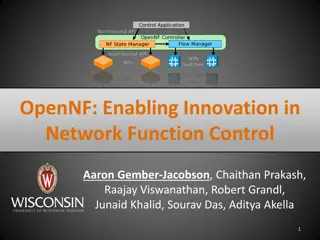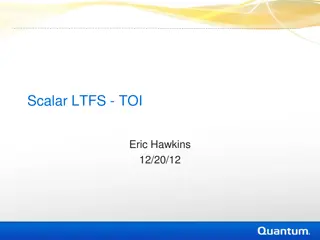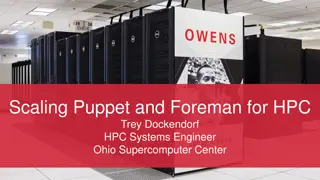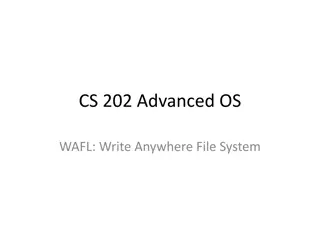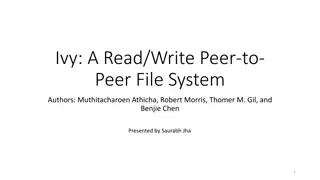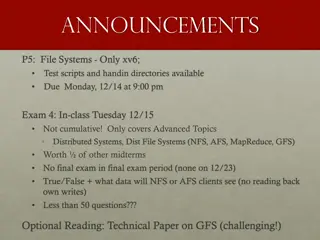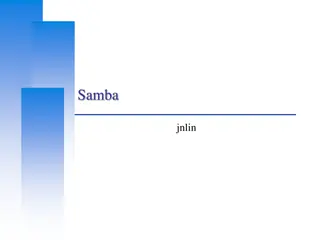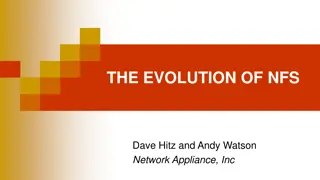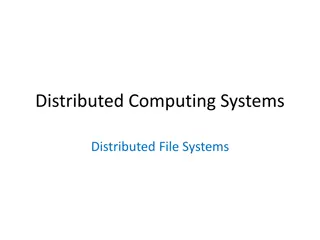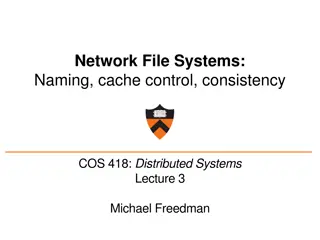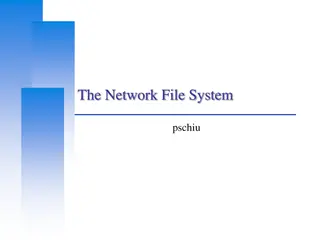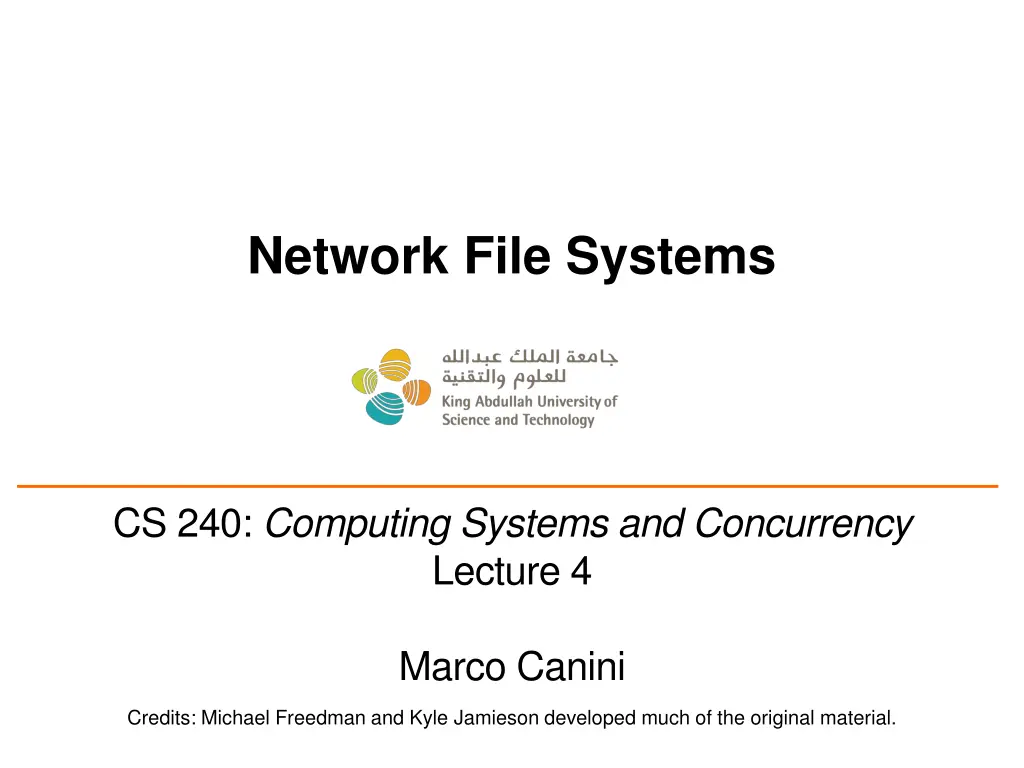
Understanding NFS Architecture and Stateless Operation
Explore the architecture and operation of NFS (Network File System) focusing on making remote file systems appear local, maintaining consistency and speed. Dive into the concepts of VFS (Virtual File System), stateless NFS approach, and more for a comprehensive understanding.
Download Presentation

Please find below an Image/Link to download the presentation.
The content on the website is provided AS IS for your information and personal use only. It may not be sold, licensed, or shared on other websites without obtaining consent from the author. If you encounter any issues during the download, it is possible that the publisher has removed the file from their server.
You are allowed to download the files provided on this website for personal or commercial use, subject to the condition that they are used lawfully. All files are the property of their respective owners.
The content on the website is provided AS IS for your information and personal use only. It may not be sold, licensed, or shared on other websites without obtaining consent from the author.
E N D
Presentation Transcript
Network File Systems CS 240: Computing Systems and Concurrency Lecture 4 Marco Canini Credits: Michael Freedman and Kyle Jamieson developed much of the original material.
Abstraction, abstraction, abstraction! Local file systems Disks are terrible abstractions: low-level blocks, etc. Directories, files, links much better Distributed file systems Make a remote file system look local Today: NFS (Network File System) Developed by Sun in 1980s, still used today! 2
3 Goals: Make operations appear: Local Consistent Fast 3
NFS Architecture Server 1 Client (root) Server 2 (root) (root) export . . . vmunix usr nfs Remote Remote people users students x staff mount mount big jon bob . . . jim ann jane joe Mount remote FS (host:path) as local directories
VFS / Local FS fd = open( path , flags) read(fd, buf, n) write(fd, buf, n) close(fd) Server maintains state that maps fd to inode, offset 7
Stateless NFS: Strawman 1 fd = open( path , flags) read( path , buf, n) write( path , buf, n) close(fd) 8
Stateless NFS: Strawman 2 fd = open( path , flags) read( path , offset, buf, n) write( path , offset, buf, n) close(fd) 9
Embed pathnames in syscalls? Should read refer to current dir1/for dir2/f ? In UNIX, it s dir2/f. How do we preserve in NFS? 10
Stateless NFS (for real) fh = lookup( path , flags) read(fh, offset, buf, n) write(fh, offset, buf, n) getattr(fh) Implemented as Remote Procedure Calls (RPCs) 11
NFS File Handles (fh) Opaque identifier provider to client from server Includes all info needed to identify file/object on server volume ID | inode # | generation # It s a trick: store server state at the client!
NFS File Handles (and versioning) With generation # s, client 2 continues to interact with correct file, even while client 1 has changed f This versioning appears in many contexts, e.g., MVCC (multiversion concurrency control) in DBs 13
NFS example fd = open( /foo , ...); Send LOOKUP (rootdir FH, foo ) Receive LOOKUP request look for foo in root dir return foo s FH + attributes Receive LOOKUP reply allocate file desc in open file table store foo s FH in table store current file position (0) return file descriptor to application 14
NFS example read(fd, buffer, MAX); Index into open file table with fd get NFS file handle (FH) use current file position as offset Send READ (FH, offset=0, count=MAX) Receive READ request use FH to get volume/inode num read inode from disk (or cache) compute block location (using offset) read data from disk (or cache) return data to client Receive READ reply update file position (+bytes read) set current file position = MAX return data/error code to app 15
NFS example read(fd, buffer, MAX); Same except offset=MAX and set current file position = 2*MAX read(fd, buffer, MAX); Same except offset=2*MAX and set current file position = 3*MAX close(fd); Just need to clean up local structures Free descriptor fd in open file table (No need to talk to server) 16
Handling server failures What to do when server is not responding? Retry again! set a timer; a reply before cancels the retry; else retry Is it safe to retry operations? NFS operations are idempotent the effect of multiple invocations is same as single one LOOKUP, READ, WRITE: message contains all that is necessary to re-execute What is not idempotent? E.g., if we had INCREMENT Real example: MKDIR is not 17
TANSTANFL (There ain t no such thing as a free lunch) With local FS, readsees data from most recent write, even if performed by different process Read/write coherence , linearizability Achieve the same with NFS? All operations appear to have executed atomically in an order that is consistent with the global Perform all reads & writes synchronously to server Huge cost: high latency, low scalability real-time ordering of operations. (Herlihy & Wing, 1991) And what if the server doesn t return? Options: hang indefinitely, return ERROR 19
Caching GOOD Lower latency, better scalability Consistency HARDER No longer one single copy of data, to which all operations are serialized 20
Caching options Centralized control: Record status of clients (which files open for reading/writing, what cached, ) Read-ahead: Pre-fetch blocks before needed Write-through: All writes sent to server Write-behind: Writes locally buffered, send as batch
Cache consistency problem Consistency challenges: When client writes, how do others caching data get updated? (Callbacks, ) Two clients concurrently write? (Locking, overwrite, ) C1 C2 C3 cache: F[v1] cache: F[v2] cache: empty Server S disk: F[v1] at first F[v2] eventually 22
Should server maintain per-client state? Stateful Stateless Pros Smaller requests Simpler req processing Better cache coherence, file locking, etc. Cons Per-client state limits scalability Fault-tolerance on state required for correctness Pros Easy server crash recovery No open/close needed Better scalability Cons Each request must be fully self-describing Consistency is harder, e.g., no simple file locking
Its all about the state, bout the state, Hard state: Don t lose data Durability: State not lost Write to disk, or cold remote backup Exact replica or recoverable (DB: checkpoint + op log) Availability (liveness): Maintain online replicas Soft state: Performance optimization Then: Lose at will Now: Yes for correctness (safety), but how does recovery impact availability (liveness)? 24
NFS Stateless protocol Recovery easy: crashed == slow server Messages over UDP (unencrypted) Read from server, caching in NFS client NFSv2 was write-through (i.e., synchronous) NFSv3 added write-behind Delay writes until close or fsync from application 25
Exploring the consistency tradeoffs Write-to-read semantics too expensive Give up caching, require server-side state, or Close-to-open session semantics Ensure an ordering, but only between application close and open, not all writes and reads. If B opens after A closes, will see A s writes But if two clients open at same time? No guarantees And what gets written? Last writer wins 26
NFS Cache Consistency Recall challenge: Potential concurrent writers Cache validation: Get file s last modification time from server: getattr(fh) Both when first open file, then poll every 3-60 seconds If server s last modification time has changed, flush dirty blocks and invalidate cache When reading a block Validate: (current time last validation time < threshold) If valid, serve from cache. Otherwise, refresh from server 27
Some problems Mixed reads across version A reads block 1-10 from file, B replaces blocks 1-20, A then keeps reading blocks 11-20. Assumes synchronized clocks. Not really correct. We ll learn about the notion of logical clocks later Writes specified by offset Concurrent writes can change offset 28
Server-side write buffering xxxxxxxxxxxxxxxxxxxxxxxxxxxxxxxxxxxxxxxxxxxxxxxxxxxxxxxxxxxx yyyyyyyyyyyyyyyyyyyyyyyyyyyyyyyyyyyyyyyyyyyyyyyyyyyyyyyyyyyy zzzzzzzzzzzzzzzzzzzzzzzzzzzzzzzzzzzzzzzzzzzzzzzzzzzzzzzzzzzz write(fd, a_buffer, size); // fill first block with a s write(fd, b_buffer, size); // fill second block with b s write(fd, c_buffer, size); // fill third block with c s Expected: aaaaaaaaaaaaaaaaaaaaaaaaaaaaaaaaaaaaaaaaaaaaaaaaaaaaaaaaaaaa bbbbbbbbbbbbbbbbbbbbbbbbbbbbbbbbbbbbbbbbbbbbbbbbbbbbbbbbbbbb cccccccccccccccccccccccccccccccccccccccccccccccccccccccccccc But assume server buffers 2nd write, reports OK but then crashes: aaaaaaaaaaaaaaaaaaaaaaaaaaaaaaaaaaaaaaaaaaaaaaaaaaaaaaaaaaaa yyyyyyyyyyyyyyyyyyyyyyyyyyyyyyyyyyyyyyyyyyyyyyyyyyyyyyyyyyyy cccccccccccccccccccccccccccccccccccccccccccccccccccccccccccc Server must commit each write to stable (persistent) storage before informing the client of success 29
When statefulness helps Callbacks Locks + Leases 30
NFS Cache Consistency Recall challenge: Potential concurrent writers Timestamp invalidation: NFS Callback invalidation: AFS, Sprite, Spritely NFS Server tracks all clients that have opened file On write, sends notification to clients if file changes; client invalidates cache Leases: Gray & Cheriton 89, NFSv4 31
Locks A client can request a lock over a file / byte range Advisory: Well-behaved clients comply Mandatory: Server-enforced Client performs writes, then unlocks Problem: What if the client crashes? Solution: Keep-alive timer: Recover lock on timeout Problem: what if client alive but network route failed? Client thinks it has lock, server gives lock to other: Split brain 32
Leases Client obtains lease on file for read or write A lease is a ticket permitting an activity; the lease is valid until some expiration time. Read lease allows client to cache clean data Guarantee: no other client is modifying file Write lease allows safe delayed writes Client can locally modify then batch writes to server Guarantee: no other client has file cached
Using leases Client requests a lease May be implicit, distinct from file locking Issued lease has file version number for cache coherence Server determines if lease can be granted Read leases may be granted concurrently Write leases are granted exclusively If conflict exists, server may send eviction notices Evicted write lease must write back Evicted read leases must flush/disable caching Client acknowledges when completed 34
Bounded lease term simplifies recovery Before lease expires, client must renew lease Client fails while holding a lease? Server waits until the lease expires, then unilaterally reclaims If client fails during eviction, server waits then reclaims Server fails while leases outstanding? On recovery, Wait lease period + clock skew before issuing new leases Absorb renewal requests and/or writes for evicted leases
Requirements dictate design Case Study: AFS 36
Andrew File System (CMU 1980s-) Scalability was key design goal Many servers, 10,000s of users Observations about workload Reads much more common than writes Concurrent writes are rare / writes between users disjoint Interfaces in terms of files, not blocks Whole-file serving: entire file and directories Whole-file caching: clients cache files to local disk Large cache and permanent, so persists across reboots
AFS: Consistency Consistency: Close-to-open consistency No mixed writes, as whole-file caching / whole-file overwrites Update visibility: Callbacks to invalidate caches What about crashes or partitions? Client invalidates cache iff Recovering from failure Regular liveness check to server (heartbeat) fails. Server assumes cache invalidated if callbacks fail + heartbeat period exceeded
Next lecture topic: Google File System (GFS) 39



